Fiasco Italo-Brittanico
Part 7: 1989 - The first Alfa Romeo-powered CART racer
Author
- Henri Greuter
Date
- March 4, 2009; revised on April 3, 2009, through the generous assistance of Johnny Capels
Related articles
- March-Alfa Romeo 90CA - Fiasco Italo-Brittanico, by Henri Greuter
- Introduction
- Part 1: Alfa's inverse Midas touch
- Part 2: Indy teams keep on March-ing
- Part 3: The Indy project that became a blackmail project
- Part 4: Patrick Racing, a brief history up to 1989
- Part 5: 1989 - Alfa picking up the pieces
- Part 6: 1989 - Winning major prizes on the road to losing everything
- Part 8: 1989 - A hopeful start for Alfa Romeo
- Part 9: Preparing for 1990
- Part 10: The 90CA in more detail
- Part 11: Exhaust solutions a 'waste' of effort?
- Part 12: 90CA on active duty - up to halfway into the month of May
- Part 13: 90CA on active duty - the early part of the second week of practice at Indianapolis
- Part 14: 90CA on active duty - wrestling through the second week of practice and qualifying
- Part 15: 90CA on active duty - about the Alfa Romeo V8 engine
- Part 16: 90CA on active duty - the last part of 'Indianapolis'
- Part 17: 90CA on active duty - after Indianapolis
- Part 18: The end of the road for March in CART and as a whole
- Part 19: The left-over hardware and where to find it
- Part 20: Final verdict on the March-Alfa Romeo 90CA
- Appendix I: Specifications
- Appendix II: Results and scores
- Appendix III: March-Alfa Romeo 90CA-related collectables and memorabilia
- March-Porsche 90P - The last oddball at the Indianapolis Motor Speedway, by Henri Greuter
What?no March-Alfa Romeo 89CE... Where?Indianapolis When?1989 Indianapolis 500 |
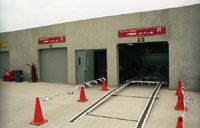 |
Why?
Since March 1989, both Guerrero and Bruno Giacomelli were testing the car supplied by Capels Racing, the March 88C chassis 009, now fitted with the brand-new Alfa V8. The first runs with the 88C were on March 23rd. The car was tested on the `Junior track` at Monza but tests also took place at Mugello. For some high-speed tests they went to the Nardo track in order to validate the potential of the engine, at that time rated at 680 hp.
Added in September 2017:
Photos of the tests at Monza taking place on March 22, 1989 have appeared since but one of these pics yields yet another mystery. In the background appears another single-seater in the pit lane. The car isn't visible in its entirety which makes it difficult to identify, but it appears to me that it is another 88C. However, to the best of my knowledge, only one of the Alex Morales Racing 88Cs ever went over to Italy: the aforementioned 88C-009. Did the other Morales owned car also make the journey to Italy after all? Or is this another car, and if so, which one? And was it used as a test car for the Alfa V8 engine or was it still fitted with a Cosworth?
Meanwhile, work on the new 89CE kept going. The intention was that the car was to be tested on the Phoenix one-mile oval before heading to Indianapolis.
The 89CE has been described as having an identical cockpit section to the 88C but being one inch lower, with its fuel cell area lowered in order to reduce the centre of gravity. Ground-effect tunnels were revised to gain more downforce for more stability and less pitch sensitivity. The car employed a pushrod linkage front-suspension system instead of the pullrod system as used on the 88C. The tub was claimed to be the stiffest ever built by March.
A new transmission case was designed to accept the Alfa V8 and the rear suspension system was redesigned as well. The transmission’s internal components were still the hypoid type ring and pinion gears as used on the 88C.
The three B&W pictures presented her originate from press kits about the 89CE. These are reprints I obtained.
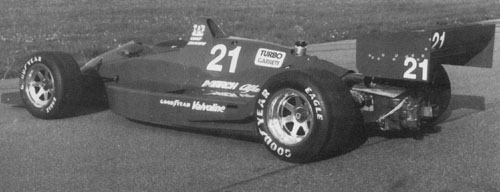
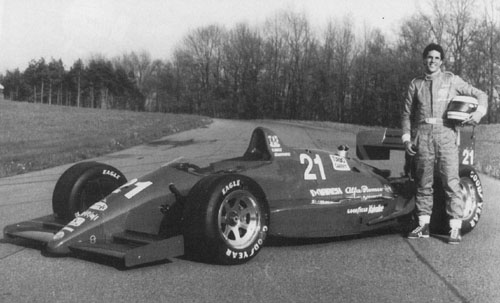
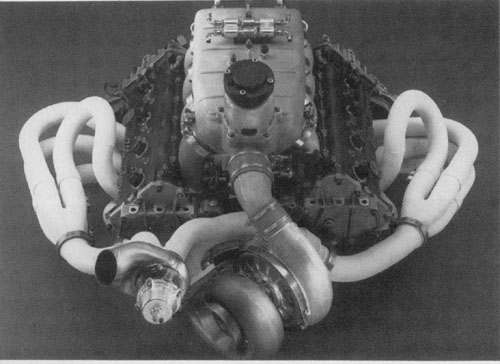
A presskit about the 89CE as released by Alfacorse can be found here while more pictures of the March 89CE-Alfa Romeo as they appeared in an Alfacorse presskit can be found here.
According the records two 89CEs were built. Elsewhere it is said that one of the 89CEs was basically a regular 88C modified to accept an Alfa Romeo V8. Also, the two cars named 89CE were said to differ from each other: one had pushrod front suspension, the other was pullrod like the 88C, a fact supporting the claim that one of the cars was nothing else but a modified Alfa-powered 88C. This information, however, is not quite correct. There were indeed two 89CEs built and used but it is true that the 88C test car (88C-009) eventually returned to the USA, primarily for testing duties.
The 89CE chassis 01 has gone to the collection of the Museo Alfa Romeo in Arese, Italy. Here are some pictures of the car as it looked in 2007. Thanks to Arjan de Roos for providing these pictures.

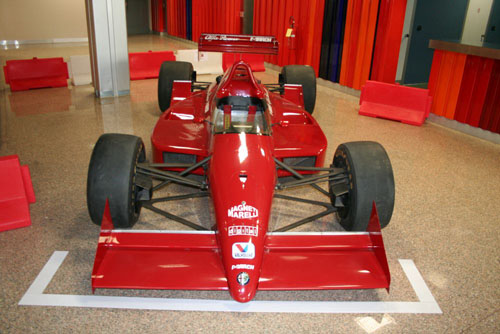
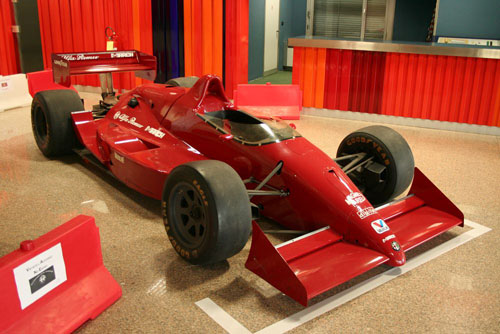

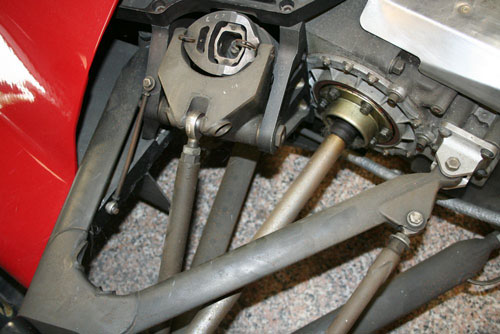
The reality about the 89CE
The information released to the press about the 89CE has been proven to be too optimistic in several respects.
Johnny Capels's crew completed the two 89C cars, and discovered that it had a complete miscalculation on the makeup of the tub and the torsional rigidity it should have. There was however no more opportunity to correct this and the cars went to the USA as they were and raced.
The 88C, which had served as the engine R&D car, had pushrod suspension and a much stiffer monocoque and eventually went back to the States. In its hybrid state, it was reported to be a slightly better performing car.
It has appeared in print that Roberto Guerrero preferred the 89CE which was based around a modified 88C tub but this is not entirely correct. There were indeed two 89CEs in existence and the team eventually had a third chassis on hand as well: the hybrid 88C.
A false start for Alfa Romeo…
Anticipating the eagerly awaited debut at Indianapolis, Alfa was then struck by a mishap as the infamous labour strikes in Italy interfered once again.
Though the team had entered Indianapolis, the entries were withdrawn due to setbacks that were said to be a result of strikes within Italy. The story goes that the team was supposed to have 15 engines ready to go early May but this commitment became impossible to meet due to the strikes. As a result of these setbacks, the team concluded that the Indianapolis race came too early for the team to make its debut and it was postponed to another almost equally daunting place: Detroit, the Motor City.
Roberto Guerrero was looking forward to the future but felt a bit annoyed by the fact that his Alfa paymasters precluded him from accepting other offers to participate at Indianapolis.
The program for the Indianapolis 500 miles race that year listed three entries by the Capels-Alfacorse team, numbers 21 and 27 were described as being 1989 March-Alfa Romeos, the number 34 was a 1988-type March. The use of the numbers 21 and 34 in particular was a result of the Team Morales background. In 1988 the team had entered two cars with these numbers. But as happened so often, teams or drivers preferred to use a certain number so the backup car, entered under a different number, was often driven with the same number of the primary car but with a T behind it. That explains why Howdy Holmes drove his backup car entered as 34 as 21T and after qualifying it was officially renumbered 21.
The car entered in 1988 was indeed 88C-009. So this chassis was entered under number 34 for the second year in a row.
What would Alfa’s chances have been to qualify for the “500”? It’s difficult to work out. Most likely the team would have had a very difficult time. The programme had been started only recently, the March 88C chassis had not obtained a very solid reputation at the Speedway the year before, so one might have had doubts about an improved version. No doubt the publicity for Alfa would have been considerable if they had made it to Indy. But what the performance would have been during the month leaves many question marks. Postponing the debut, disappointing as it was, was not such a bad and illogical decision.
The thought that any March 88C, improved or not, was in for a difficult time at Indianapolis in May 1989 is supported by the fact that only two Cosworth DFX-powered 88Cs qualified for the race. The first was the Machinists Union entry driven by Kevin Cogan. The other serious 88C-DFX entry was for well-known dirt tracker Rich Vogler but he failed to qualify both his cars. He then took over Cogan’s backup car on the final day of qualifying to creep into the field on the final row. Curiously enough, both these two 88Cs had been back-up cars the year before and thus made their debut in the “500”.
Steve Saleen was another entrant of two 88C-DFXs, crashing one while the second one wasn’t fast enough for himself and a number of other drivers trying it. To add insult to the capabilities of the one-year-old 88C, Rocky Moran qualified an AJ Foyt-entered 86C-DFX for its fourth race in succession! Knowing all this, how to rate the chances for Roberto Guerrero to qualify a 88C derivative fitted with what was likely to be an engine with less power than a Cosworth DFX? Of course, the 89CE was, at least on paper, not just a renamed but slightly modified 88C so the far from optimistic view about its performance may have been too pessimistic. But the results of the team once they did participate may well support the theory that Alfa would have had a very hard time at Indianapolis, had they indeed showed up.
The excuse of strikes causing trouble to Italian racing teams has been heard before. In this case, however, there is cause to doubt it. According to Johnny Capels, there had indeed been problems with the engines being finished in time but he hadn't been aware of strikes taking place in Italy. Work was carried out all the time and there was a lot of faxing and telephoning going on. The team had built up the chassis and these were ready in time.
But whatever was cited as the reason for the withdrawal, the team had to withdraw because the engines weren't ready for use, neither in quantity nor at the level of performance needed. Johnny Capels confessed that, had it been possible to run at the Speedway, it would have been doubtful whether the team could have qualified for the race, given the engine's performance at that time.
Another remark by Capels in which he confirmed that it had been the engines causing the withdrawal at Indianapolis tells a bit more about how the 89CE must be looked at. Capels wrote: “With our help in the March shop we did have two new 89 March models ready for Indy but the progress of the engines was not to Alfa's satisfaction. The March chassis was conceived very quickly and basically was not anything new.”
Which supports a lot of claims about the 88C heritage of the 89CE, with practically no input of the 89P project into the “in-house opponents” at March.
Incidentally, garage space at the Speedway grounds was allocated to the team but went unused. Eventually USAC used the free garages for some of their own measurement devices.

These were the two garages allocated to the Capels-Alfacorse team in Gasoline Alley. Eventually they were used by USAC for car inspection. (photo HG)
As far as Alfa’s progress during May 1989 was concerned, it was reported that Alfa was testing its eighth prototype engine.
